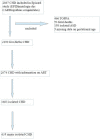Assessing the risk of preterm birth for newborns with congenital heart defects conceived following infertility treatments: a population-based study
- PMID: 30402257
- PMCID: PMC6203020
- DOI: 10.1136/openhrt-2018-000836
Assessing the risk of preterm birth for newborns with congenital heart defects conceived following infertility treatments: a population-based study
Abstract
Objectives: To quantify the risk of preterm birth (PTB) for newborns with congenital heart defects (CHDs) conceived following infertility treatments, and to examine the role of multiple pregnancies in the association between infertility treatments and PTB for newborns with CHD.
Methods: We used data from a population-based, prospective cohort study (EPICARD EPIdémiologie des CARDiopathies congénitales) including 2190 newborns with CHD and excluding cases with atrial septal defects born to women living in the Greater Paris area between May 2005 and April 2008. Statistical analysis included logistic regression to take into account potential confounders (maternal characteristics, invasive prenatal testing, CHD prenatal diagnosis, medically induced labour/caesarean section before labour, birth year). The role of multiple pregnancies was assessed using a path-analysis approach, allowing decomposition of the total effect of infertility treatments on the risk of PTB into its indirect (mediated by the association between infertility treatments and multiple pregnancies) and direct (mediated by mechanisms other than multiple pregnancies) effects.
Results: PTB occurred for 40.6% (95% CI 28.7 to 52.5) of newborns with CHD conceived following infertility treatments vs 12.7% (95% CI 11.3 to 14.2) for spontaneously conceived newborns (p<0.001). After taking into account potentially confounding factors, infertility treatments were associated with a 5.0-fold higher odds of PTB (adjusted OR=5.0, 95% CI 2.9 to 8.6). Approximately two-thirds of this higher risk of PTB associated with infertility treatments was an indirect effect (ie, due to multiple pregnancies) and one-third was a direct effect (ie, not mediated by multiple pregnancies).
Conclusion: Newborns with CHD conceived following infertility treatments are at a particularly high risk of PTB, exposing over 40% of them to the 'double jeopardy' of CHD and PTB.
Keywords: congenital heart disease; epidemiology; paediatric cardiology.
Conflict of interest statement
Competing interests: None declared.
Figures
References
-
- Sunderam S, Kissin DM, Crawford SB. Assisted reproductive technology Surveillance - United States, 2014. MMWR Surveill Summ 2017;66:1–24. doi:10.15585/mmwr.ss6606a1 - DOI - PMC - PubMed
Publication types
LinkOut - more resources
Full Text Sources
Miscellaneous

